What are Centipedes?
Centipedes, belonging to the class Chilopoda, are arthropods characterized by their distinctive segmented bodies and numerous legs. Despite their name, the number of legs in centipedes varies, ranging from 15 to 177 pairs. Each body segment bears a single pair of long, slender legs, contributing to their rapid and agile appearance. The first segment features venomous claws or fangs known as forcipules, used to inject venom into their prey. Centipedes have a pair of antennae on their heads for sensory perception.
Found in diverse environments, including forests, grasslands, and urban areas, they thrive in moist and dark places. Carnivorous by nature, centipedes play a beneficial role in controlling insect populations by actively hunting insects and small invertebrates.
While larger species can deliver a mild, venomous bite if handled, centipedes are generally more helpful than harmful in the context of pest control.
What Kinds of Centipedes are There?
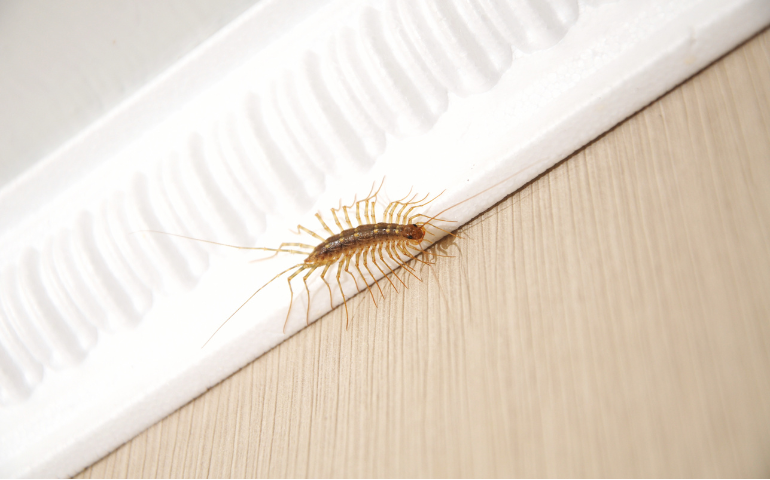
House centipedes are long-bodied, flattened creatures with bodies up to 1-1/2 inches in length. The body is yellowish-brown and has three dark stripes along its top with lighter shading in the middle.
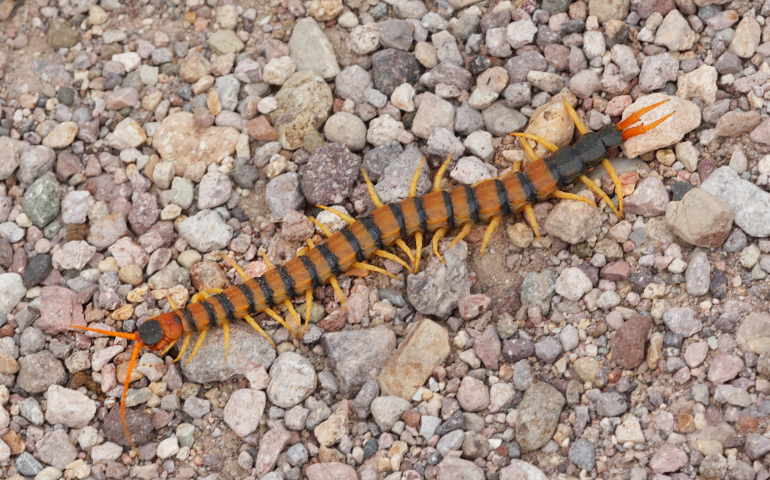
Giant Desert Centipedes measure approximately 6.5 inches in length on average, but can grow up to 8 or 9. The head and the first two segments of the body are different shades of red. Other body segments are black, with traces green, but there are many variations.
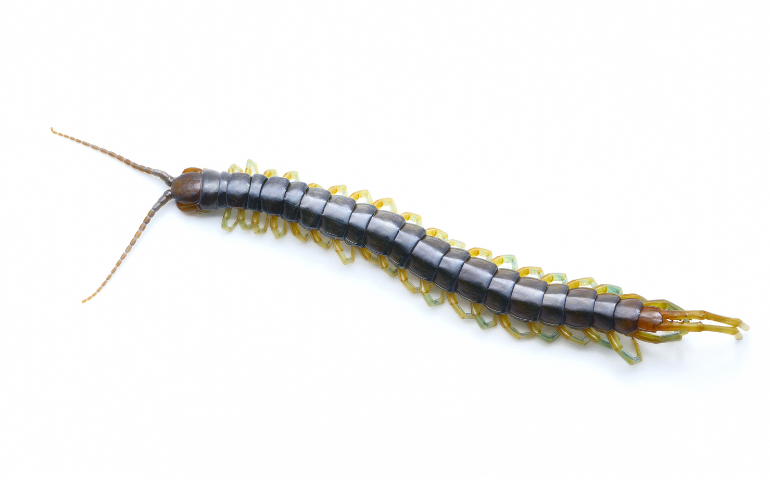
Black Centipedes can grow between 5-inches and 10 inches in size with an average height of seven-inches. Like other centipedes with venomous claws, black centipedes dig into prey to neutralize it.
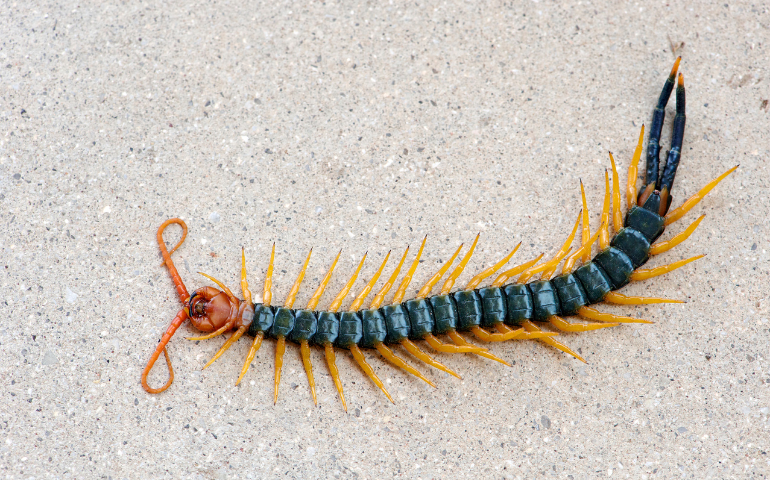
Texas redheaded centipedes are also known as giant desert centipedes. They can grow up to 8 or nine inches in length. The head and the first two segments of the body are different shades of red, while the rest of their body are black with traces green.
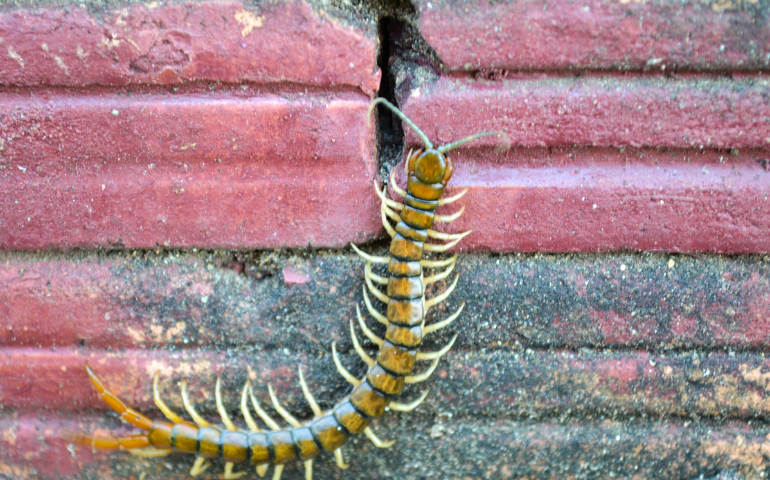
Often found in humid environments such as greenhouses, these centipedes have a unique appearance with a bright green color.
Where Do I Find Centipedes?
Centipedes can be found in a variety of environments, and their habitats can vary depending on the species. They are commonly found in:
Moist and Dark Environments:
Centipedes thrive in areas with high humidity, making damp and dark places ideal for their survival. This includes locations such as basements, bathrooms, crawl spaces, and under rocks or logs outdoors.
Soil and Leaf Litter:
Many centipede species are soil-dwelling and are often found in leaf litter, garden beds, and areas with loose soil. They play a crucial role in controlling insect populations in these environments.
Wooded Areas:
Centipedes can be found in wooded or forested areas, where the abundance of organic matter and moisture provides a suitable habitat.
Urban Environments:
Some species of centipedes, like the house centipede, are adapted to urban environments and may be found indoors. They often hide in dark and secluded areas such as closets, basements, and under furniture.
Are Centipedes Nocturnal?
Although they may be allowed to enter buildings and houses, centipedes do not roam freely during the day. Centipedes can move fast, are agile, and are nocturnal. They are attracted to damp places such as basements, closets, basements, and other areas that are infested with pests.
What Do Centipedes Eat?
Centipedes are carnivorous predators that primarily feed on a variety of small invertebrates. Their diet includes insects and other arthropods, making them beneficial in controlling populations of pests. Some common prey items for centipedes include:
- Insects: Centipedes actively hunt and feed on a wide range of insects, including ants, spiders, termites, cockroaches, silverfish, and beetle larvae.
- Worms: Certain centipede species may prey on earthworms and other small soil-dwelling organisms.
- Arachnids: Centipedes often consume spiders, mites, and other arachnids.
- Invertebrates: Small invertebrates such as springtails and insect larvae are part of the centipede’s diet.
Do Centipedes Cause Damage?
Centipedes do not cause significant damages to structures, furniture, or belongings like some other pests do. Unlike termites, rodents, or certain insect pests that can cause structural damage or damage to stored items, centipedes primarily focus on preying on other small invertebrates. Their diet consists mainly of insects, spiders, and other arthropods.
Do Centipedes Bite?
Centipedes can be venomous. Centipedes are equipped with venomous forcipules (modified front legs) that they use to inject venom into their prey. While centipedes are not aggressive toward humans, they may bite if handled or feel threatened. Bites from most centipede species are generally mild and result in temporary pain, redness, and swelling. Rarely, individuals may experience a stronger reaction.
Lifespan Of A Centipede
The lifespan of a centipede varies based on factors like species, environmental conditions, and individual circumstances. Typically, centipedes have relatively short lifespans, ranging from one to three years for most species, though larger centipedes may live up to six years.
Their life cycle involves hatching from eggs into nymphs, undergoing molting stages, and reaching adulthood. Reproduction is a crucial aspect of their life, with females laying eggs in the soil, leading to the development of young centipedes.
Environmental factors such as temperature, humidity, and food availability significantly influence their lifespan, and suitable conditions contribute to their overall well-being and longevity. While centipedes play important roles in controlling insect populations, their lifespans are relatively brief compared to some other arthropods.
How To Get Rid Of Centipedes:
Reduce Humidity:
- Centipedes thrive in high humidity. Use dehumidifiers in damp areas like basements and bathrooms to lower moisture levels.
- Ensure proper ventilation to reduce humidity in enclosed spaces.
Seal Entry Points:
- Inspect and seal any cracks, gaps, or openings in the exterior of your home, especially around windows, doors, utility lines, and vents.
- Use weather stripping on doors and windows to prevent centipedes from entering.
Remove Hiding Spots:
- Declutter areas where centipedes may find hiding spots, such as piles of papers, cardboard boxes, or old clothing.
- Regularly vacuum and clean spaces where centipedes are likely to hide.
Natural Repellents:
- Use natural repellents like diatomaceous earth in areas where centipedes are present. This desiccant can help control their population.
- Consider using essential oils like peppermint or cedar oil, as these scents are known to deter centipedes.
Insecticides:
- Apply residual insecticides in cracks, crevices, and other hiding spots. Choose insecticides labeled for centipede control.
- Boric acid in powder form can be effective; however, use caution and follow product instructions.
Professional Pest Control:
- If the infestation persists or is severe, consider seeking professional pest control services.
- Pest control professionals can assess the situation and provide targeted solutions based on the specific conditions of your home.
Regular Maintenance:
- Implement ongoing preventive measures, including regular cleaning, decluttering, and maintenance of a low-humidity environment.
- Seal entry points and address any conditions that may attract centipedes to your home.
